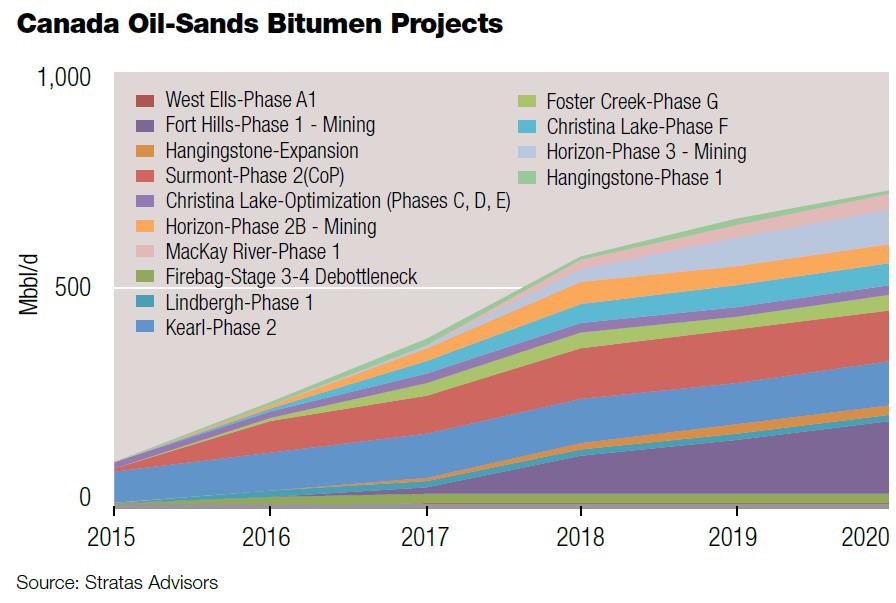Canadian oil-sands production has had resilient low oil prices over the past three years. The largest supply disruption was from a wildfire near Fort McMurray, Alberta, last year which temporarily knocked out about 1 million barrels per day (MMbbl/d) of production.
However, the first quarter of 2017 was very eventful on Canadian oil sands. While the prolonged downturn continues into 2017 with the price of oil hanging around $50, where is oil-sands development heading?
Supply disruption
On March 14, an explosion followed by a fire at Syncrude’s Mildred Lake upgrader caused the shutdown of the entire facility. The damaged plant, which can process up to 350,000 bbl/d of bitumen, was then under maintenance. Suncor Energy announced on April 19 that the maintenance of the facility had been completed and production restarted.
The shutdown of the upgrader caused a shortage of synthetic crude, and as a result, several projects that used the synthetic crude to dilute bitumen also had to cut production.
Among them, ConocoPhillips Co. reduced output by 40% at its 140,000-bbl/d Surmont oil-sands project, and Nexen Energy reduced production by 48% at its 40,000-bbl/d Long Lake project.
In addition, several scheduled maintenances also knocked down production at Suncor Energy’s 300,000-bbl/d Steepbank facility and 180,000-bbl/d Firebag operations and Shell’s 255,000-bbl/d Athabasca facility.
As a result, the overall crude supply in the second quarter of 2017 demonstrated a considerable drop of 315,000 bbl/d on average compared with the first quarter. Light sweet synthetic crude oil production was mostly impacted, with a drop of 200,000 bbl/d, followed by heavy sour synthetic crude, with a drop of 66,000 bbl/d, and dilbit (blended bitumen), with a drop of 37,000 bbl/d.
Majors exit
Secondly, there are the gush of exits of oil-sands operations from oil majors. In February, ExxonMobil Corp. wrote off 3.3 billion oil-sands reserve barrels from its books, mostly on the 3.5-Bbbl Kearl oil-sands development as low oil prices made it uneconomical to extract those reserves within five years. ConocoPhillips also made reserve reductions of about 1.2 Bbbl at the Surmont, Foster Creek, Christina Lake and Narrow Lakes projects.

At the beginning of March, Shell signed a deal with Canadian Natural Resources Ltd. (CNRL) to sell all of its in-situ and undeveloped oil-sands interests in Canada and reduce its share in the Athabasca oil-sands project (AOSP) from 60% to 10%. Shell will remain as the operator of AOSP’s Scotford upgrader and the Quest carbon capture and storage project. It made the deal under the pressure to sell assets totaling $30 billion to cut debt following its $54-billion acquisition of BG Group and to mitigate climate change risks.
By the end of March, ConocoPhillips signed an agreement to sell its 50% interest in the Foster Creek Christina Lake (FCCL) oil-sands assets to Cenovus Energy Inc. For ConocoPhillips, the deal is to restructure its balance sheet on rapid debt reduction and share repurchase. The company will retain its operated 50% interest in the Surmont oil sands.
Also, Chevron is reportedly exploring the chances to sell its 20% stake in AOSP, and BP is considering selling its interests in three assets. BP owns a 50% stake in the Sunrise project, a 50% stake in the Pike project and a 75% stake in the Terre de Grace pilot project.
Outlook of oil sands
Low oil prices have finally forced the majors to trim their upstream portfolios, refocus on core assets and restructure their deteriorated balance sheets. As the majors exit oil sands, the question becomes: “Are oil sands dying?” The majors sent a strong signal that they are seeing an era of low oil prices in the foreseeable future.
On the other hand, the two buyers on the other side of the deals, CNRL and Cenovus Energy, both main Canadian oil-sands producers, are looking to strengthen and optimize their oil-sands asset portfolio. Cenovus Energy is especially betting on the long-term prospects of oil sands. They are planning to resume the development of Foster Lake Phase H and the Cristina Lake G expansion while being the sole owner of those assets.
Stratas Advisors believes, for the short term, oil-sands bitumen production will continue to grow to above 2.7 MMbbl/d in the next couple of years driven by new source projects sanctioned before the price collapse in 2014. However, no major oil-sands projects have been sanctioned since then. The undeveloped reserves will most likely be untapped until the price of oil recovers to be above $60, which would put some projects economically viable especially those expansion projects.
Recommended Reading
Innovative Insulation: The Future of Thermal Management
2024-12-31 - Silicone-based, spray-on coating simplifies application and improves protection for downstream assets and workers.
E&P Highlights: Dec. 16, 2024
2024-12-16 - Here’s a roundup of the latest E&P headlines, including a pair of contracts awarded offshore Brazil, development progress in the Tishomingo Field in Oklahoma and a partnership that will deploy advanced electric simul-frac fleets across the Permian Basin.
Delivering Dividends Through Digital Technology
2024-12-30 - Increasing automation is creating a step change across the oil and gas life cycle.
E&P Highlights: Jan. 27, 2025
2025-01-27 - Here’s a roundup of the latest E&P headlines including new drilling in the eastern Mediterranean and new contracts in Australia.
E&P Highlights: Jan. 21, 2025
2025-01-21 - Here’s a roundup of the latest E&P headlines, with Flowserve getting a contract from ADNOC and a couple of offshore oil and gas discoveries.
Comments
Add new comment
This conversation is moderated according to Hart Energy community rules. Please read the rules before joining the discussion. If you’re experiencing any technical problems, please contact our customer care team.




